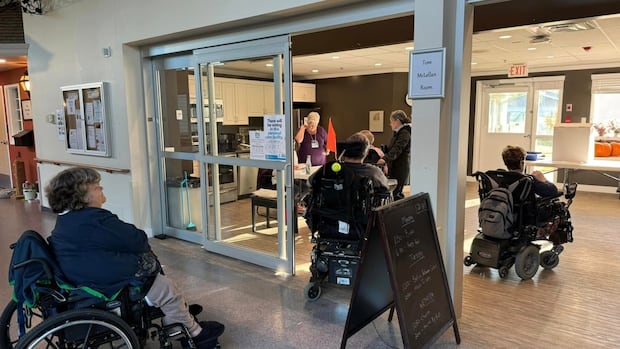Karthik Babu Menon is ready to vote in his first-ever federal election, but he’s not just thinking about how to mark his ballot, but also about the potential challenges he might face in getting into the voting booth.
In previous elections, he’s found voting fairly accessible as someone who uses a walker to get around Saskatoon, but he thinks there’s still ways to make voting even easier, for instance, by getting rid of pencil and paper voting.
“I would definitely prefer something which has touch technology, like touch screens,” he said, explaining he was born with cerebral palsy and can struggle with dexterity with his hands, as well as with muscle control and coordination with his legs.
Babu Menon isn’t just familiar with accessibility issues from a personal perspective. He also works as a client services coordinator at Spinal Cord Injury Saskatchewan, and knows that clients can have a difficult time getting out to voting stations.

“My clients, a lot of them use access transit. With Access Transit, you have to book in advance to go; there’s some times they can’t get trips going out to polls,” he said, adding he knows some people with disabilities may prefer to mail in their ballot, but that’s not always the case.
“Some of them prefer going out to vote, just exercise [their] right.”
Across the voting landscape, voters with disabilities face a number of barriers that aren’t just tied to whether a polling location has an accessible door opener or wide enough door frames — two of the 15 criteria Elections Canada uses to determine a polling station’s accessibility.
Research done by Elections Canada has found that disabled electors are less likely to vote than those without disabilities, less likely to know about alternative methods of voting, and that those with disabilities are significantly less likely to be content with the information provided surrounding the election.
Marie-France Kenny, a regional media advisor with Elections Canada, said that the government agency is committed to ensuring that voters with disabilities have the best experience they can.
Elections organizers and workers have tried to improve access over time, when it comes to making sure people can vote close to home, that the space is accessible and that everyone has the tools to vote.
“It’s an ongoing process,” she said, adding that the organization is open to feedback.
“So, if tomorrow somebody comes out with a brilliant idea on how to make it more accessible, then of course, Elections Canada will investigate and will implement, if it’s a feasible solution.”
Part of that process has coincided with the passing of the Accessible Canada Act, the creation of an advisory group in 2014, and the development of multiple progress reports to ensure voting is accessible.
Some voters won’t even have to leave their home to vote. A number of long-term care facilities will have polling stations on election day, including at Sherbrooke Community Centre.
“The fact that we can have a polling station here at Sherbrooke for 12 hours on election day is pretty fantastic,” said Eric Anderson, communications leader at the centre, adding this will make it easier and more accessible for the facility’s 263 residents to vote.
Another facility administrated by Sherbrooke, Central Haven Special Care Home, which is home to 60 people, will also have a two-hour voting window on Monday.
“Voices of residents in long-term care matter … and they should be heard,” Anderson said, “And we appreciate it when candidates do drop by to introduce themselves and to ask questions and, most importantly, listen to residents.”
How to find accessibility information
Elections Canada has a section of its website dedicated to accessibility, including areas describing the tools and services available, what makes a polling station accessible in the eyes of the organization, what supports you can get should you need assistance from someone else to cast your ballot, and video content that is available in American Sign Language (ASL) and Langue des signes québécoise (LSQ). Information about the election in general is also available in multiple formats.
Other common accessibility options available for voters include access to different writing implements, magnifiers, access to election staff who can support the casting of a ballot, and a procedure should a voter need physical support from a friend, family member, or support person.
In that case, the person supporting is asked to sign a written declaration. A support person can only help one voter — who they aren’t related to — mark their ballot.
Voters who are unsure about the accessibility level of their polling station are urged to call 1-800-463-6868. The number to call is 1800-361-8935 if you use teletype (TTY) services.
While the formal deadline to request an interpreter in time for election day — whether it’s for sign language or another language — was April 22, Kenny said it’s still worth calling the number on your voter information card to see if an accommodation is possible.
As for what to do should you bump into any issues at the polls, or if you have suggestions for the future, Kenny said she urges people to speak to election workers and leave feedback via each station’s suggestion box.
“I do encourage people who do have a problem or have suggestions to make them, because our goal is to make voting accessible to all Canadian electors. And if there’s something we can do to improve access, then, by all means, let us know.”
